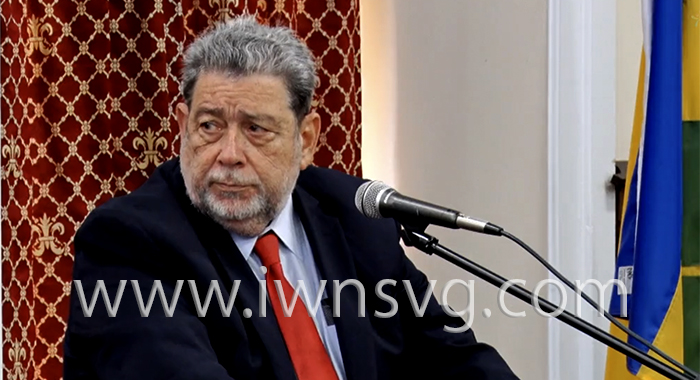Prime Minister Ralph Gonsalves says that the recent case of a man forcing a 4-year-old to perform fellatio on him, is one in which the court should have departed from the guidelines on sentencing sex offenders.
The man also filmed the child performing the sex act on at least one occasion, the first count of which occurred when the child was around 2 years old.
The prime minister, who is also minister of legal affairs, asked why no charges were brought under the Cyber Crime Act as the video of the sex act was circulated on social media.
Earlier this month, the man, who is originally from Sion Hill but lives in Mesopotamia, pleaded guilty at the Family Court to two counts of indecent assault of the child.
President of the Family Court Colleen Mc Donald sentenced him to two years in prison on each count.
The sentences will run consecutively, meaning that the man will serve a total of four years.
The court could have sentenced the man to a maximum of five years on each count.
There has been widespread public outrage over the sentence, with many people, including Opposition Leader, Godwin Friday, calling for stiffer penalties for sex crimes.
Speaking on radio on Sunday, the prime minister noted the reaction of the public, but said, “I want to ask all persons who have been talking that it’s important that we have the factual matrix.
“Of course, everybody is quite right to be appalled that [it’s] only four years.”
He noted that on Dec. 14, the Gazette published, through the Eastern Caribbean Supreme Court, sentencing guidelines rules for a range of offences.
The prime minister was referring to “A Compendium Sentencing Guideline of The Eastern Caribbean Supreme Court” on sexual offences, which was re-issued on Nov. 8.
Gonsalves read the applicability of the guideline, which says, “In sentencing for these offences, the Chief Justice has issued guidelines and the court must apply the relevant guidelines and sentence accordingly, unless to do so would not be in the interest of justice.”
Gonsalvescommented, “In other words, a magistrate or a judge can say, ‘Listen to me. I’m not going to apply these guidelines, because these guidelines, this offence, which is before me is so out of the norm, is so abhorrent that the interest of justice will not be served to apply the guidelines.”
The Supreme Court, however, says that a judge or magistrate may only depart from the guidelines in exceptional circumstances, where such departure can be justified.
“Surely, a departure could have been justified in that case,” Gonsalves said.
He noted that the guidelines say that clear reasons for not applying them must be given when passing sentence.
The chief justice says that it isexpected that every court will follow the steps below, with each relevant step being identified to the offender in public before the sentence is passed.
“Starting points and ranges apply to all adult offenders whether they have pleaded guilty or been convicted after a trial. Credit for a guilty plea is taken into consideration only at Step 3.”
Step 1 says that the judicial officer must consider the seriousness of the offence.
“Find the starting point by consulting the guideline and the grid below. Then adjust the figure within the range for the aggravating and mitigating factors of the offence.
“Step 2 Adjust the figure within the range for the aggravating and mitigating factors affecting the offender.
“Step 3 Adjust the figure on assessing discount for any plea of guilty, if applicable.
“Step 4 Adjust the figure on assessing totality if sentencing for more than one offence.”
The prime minister commented:
“You hear that? If you’re sentencing for more than one offence. This guy had two, albeit of the same. So should they have gone concurrently? Should they have gone consecutively?”
The man was sentenced to consecutive jail terms.
Step 5 of the guidelines said that the court mustcredit for time served on remand and, finally, consider ancillary orders, compensation, restraining orders, etc., if applicable.
Gonsalvessaid: “So that the guidelines are not written in stone, if you see what I mean. They are what they are: guidelines.
“Now, I’m not making a criticism of the magistrate because I was not sitting there knowing all the facts…
“And then the question is this. Why wasn’t someone charged if you had admissible evidence under the Cybercrime Act? Because I’ve been advised that this crime was on social media. As always, we must have a good discussion on what is at play. But I thought that I would introduce that discussion,” he said.
The prime minister said that his government is undertaking a comprehensive review of the nation’s sex laws and the attorney general updated the cabinet on this last Wednesday.







Absolutely outrageous!
Same how he can come out and give his opinion on Ashel case before it went to court, he should have the same energy and give his opinion when the video was circulating.
Shooting is important but not sexual offences!
As a parliamentarian why haven’t you brought stiffer penalties of the act to parliament? Why is this government always reactive and not proactive
That criminal should have gotten 20 years for the crime he committed and had the nerve to film the incident. The child should also be taken away from the mother because she is also guilty of obstruction of justice. That child is damaged for life.